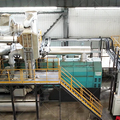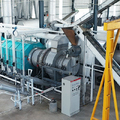In the quest for sustainable agriculture and environmental restoration, a unique solution is emerging as a game-changer: Biochar Pyrolysis. This innovative process involves the transformation of biomass into biochar, a carbon-rich material with the potential to revolutionize soil quality and agricultural practices. In this exploration, we delve into the science, benefits, and promising future of biochar pyrolysis equipment as a key player in fostering fertile landscapes and sustainable farming.

The Essence of Biochar Pyrolysis
At its core, biochar pyrolysis is a thermal decomposition process that converts biomass – such as agricultural residues, wood chips, or organic waste – into biochar through controlled heating in the absence of oxygen. The resulting biochar is a stable form of carbon that bears a porous structure, making it an excellent candidate for soil enrichment.
Carbon Sequestration and Climate Impact
One of the primary environmental benefits of biochar pyrolysis lies in its capacity for carbon sequestration. By transforming biomass into biochar, carbon that would otherwise be released into the atmosphere as CO2 during decomposition is effectively stored in a stable form. This not only mitigates greenhouse gas emissions but also contributes to long-term climate change resilience.
Unlocking Soil Potential: The Biochar Advantage
The magic of biochar lies in its ability to enhance soil properties. When incorporated into the soil, biochar acts as a sponge, holding onto essential nutrients and water, preventing leaching, and creating an optimal environment for plant growth. The porous structure of biochar also provides a refuge for beneficial microorganisms, fostering a thriving ecosystem beneath the surface.
Nutrient Retention and Water Efficiency
One of the critical roles of biochar in soil enrichment is nutrient retention. The porous nature of biochar provides a habitat for microbes and fungi that enhance nutrient availability for plants. Additionally, biochar's high cation exchange capacity allows it to hold onto essential nutrients like nitrogen, phosphorus, and potassium, releasing them gradually over time. This not only improves soil fertility but also reduces the need for synthetic fertilizers, mitigating the environmental impact of conventional farming practices.
Furthermore, biochar's water-retention properties are invaluable, especially in regions prone to drought. The porous structure allows biochar to absorb and retain water, acting as a reservoir that gradually releases moisture to plants during dry periods. This water efficiency is a crucial factor in sustainable agriculture, promoting resilience in the face of changing climatic conditions.
Improving Soil Structure and Aeration
In addition to nutrient and water management, biochar enhances soil structure. The introduction of biochar into the soil promotes aggregation, creating stable aggregates that improve soil porosity and aeration. This, in turn, facilitates better root growth, nutrient uptake, and overall plant health. Improved soil structure also reduces the risk of soil erosion and enhances the soil's ability to withstand external pressures, contributing to long-term land conservation.
Tailoring Biochar for Specific Crops
One of the exciting aspects of biochar application is its adaptability to different crops and soil types. Researchers are exploring ways to tailor biochar properties to meet the specific needs of various plants. By adjusting factors such as feedstock type, pyrolysis conditions, and biochar particle size, scientists aim to optimize biochar's impact on crop yield and soil health. This personalized approach holds immense potential for maximizing the benefits of biochar across diverse agricultural landscapes.
Biochar in Practice: Success Stories
Numerous success stories around the world showcase the tangible impact of biochar on soil fertility and crop production. In the Amazon rainforest, ancient civilizations practiced a form of biochar application known as “terra preta,” creating highly fertile soils that remain productive even today. In contemporary agriculture, farmers in various countries are incorporating biochar into their practices with remarkable results.
For instance, in Australia, where arid conditions pose significant challenges, biochar has been successfully utilized to improve water retention in sandy soils, leading to enhanced crop yields. Similarly, in sub-Saharan Africa, biochar trials have shown promise in improving soil fertility and crop productivity, offering a sustainable solution for regions facing agricultural challenges.
Challenges and Considerations
While the potential benefits of biochar pyrolysis are vast, challenges and considerations must be addressed to ensure its responsible and effective implementation. These include the need for standardized testing methods to assess biochar quality, research into the long-term effects of biochar on soil health, and considerations regarding the scalability of biochar production.
Furthermore, the sustainable sourcing of biomass feedstocks is crucial to avoid conflicts with food production and ensure that the biochar life cycle remains environmentally friendly. Balancing the positive impacts of biochar with ethical and ecological considerations is essential for realizing its full potential without unintended consequences.
The Role of Research and Innovation
Ongoing research and innovation play a pivotal role in unlocking the full potential of biochar pyrolysis. Scientists are exploring advanced pyrolysis techniques, such as slow pyrolysis and hydrothermal carbonization, to tailor biochar properties for specific applications. Additionally, investigations into the synergies between biochar and other sustainable agricultural practices, such as cover cropping and agroforestry, are expanding our understanding of integrated approaches to soil enrichment.

Embracing Fertile Futures: The Biochar Revolution
As we stand on the threshold of a pivotal agricultural transformation, biochar pyrolysis emerges as a key player in shaping fertile futures. Its ability to sequester carbon, enhance soil fertility, and promote sustainable agriculture positions biochar as a powerful tool in the arsenal against environmental degradation and climate change.
Farmers, policymakers, and researchers alike have a role to play in embracing the biochar revolution. By integrating biochar into agricultural practices, supporting research initiatives, and fostering sustainable policies, we can turn the promise of biochar into a reality. It is not merely a soil amendment; it is a catalyst for change, paving the way for a future where agriculture coexists harmoniously with the environment.
Conclusion: Cultivating Fertility, Sowing Sustainability
In the narrative of agriculture's evolution, biochar pyrolysis emerges as a transformative chapter, offering a narrative of hope and sustainability. As we cultivate fertile futures through the adoption of biochar, we sow the seeds of resilience, environmental stewardship, and a greener tomorrow. The journey towards sustainable agriculture is a shared responsibility, and in the fertile grounds enriched by biochar, we find the promise of a world where the land thrives, and our agricultural practices nurture, rather than deplete, the Earth's bounty.





